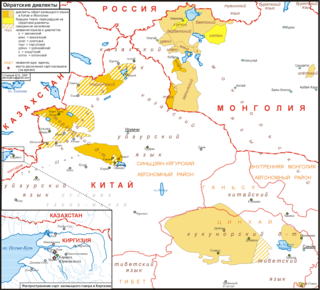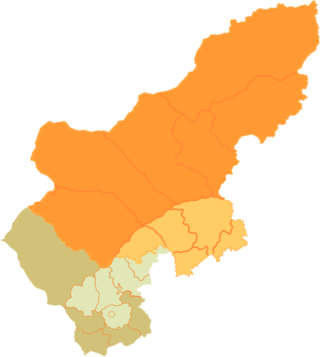Related Research Articles
In phonology, vowel harmony is an assimilatory process in which the vowels of a given domain – typically a phonological word – have to be members of the same natural class. Vowel harmony is typically long distance, meaning that the affected vowels do not need to be immediately adjacent, and there can be intervening segments between the affected vowels. Generally one vowel will trigger a shift in other vowels, either progressively or regressively, within the domain, such that the affected vowels match the relevant feature of the trigger vowel. Common phonological features that define the natural classes of vowels involved in vowel harmony include vowel backness, vowel height, nasalization, roundedness, and advanced and retracted tongue root.

Mongolian is the principal language of the Mongolic language family that originated in the Mongolian Plateau. It is spoken by ethnic Mongols and other closely related Mongolic peoples who are native to modern Mongolia and surrounding parts of East and North Asia. Mongolian is the official language of Mongolia and Inner Mongolia and a recognized language of Xinjiang and Qinghai.

The Mongolic languages are a language family spoken by the Mongolic peoples in Eastern Europe, Central Asia, North Asia and East Asia, mostly in Mongolia and surrounding areas and in Kalmykia and Buryatia. The best-known member of this language family, Mongolian, is the primary language of most of the residents of Mongolia and the Mongol residents of Inner Mongolia, with an estimated 5.7+ million speakers.
The phonology of Standard German is the standard pronunciation or accent of the German language. It deals with current phonology and phonetics as well as with historical developments thereof as well as the geographical variants and the influence of German dialects.

Tuvan or Tyvan is a Turkic language spoken in the Republic of Tuva in South Central Siberia, Russia. The language has borrowed a great number of roots from the Mongolian language, Tibetan and the Russian languages. There are small diaspora groups of Tuvan people that speak distinct dialects of Tuvan in China and Mongolia.
While many languages have numerous dialects that differ in phonology, the contemporary spoken Arabic language is more properly described as a continuum of varieties. This article deals primarily with Modern Standard Arabic (MSA), which is the standard variety shared by educated speakers throughout Arabic-speaking regions. MSA is used in writing in formal print media and orally in newscasts, speeches and formal declarations of numerous types.

Buryat or Buriat, known in foreign sources as the Bargu-Buryat dialect of Mongolian, and in pre-1956 Soviet sources as Buryat-Mongolian, is a variety of the Mongolic languages spoken by the Buryats and Bargas that is classified either as a language or major dialect group of Mongolian.
In phonetics, vowel reduction is any of various changes in the acoustic quality of vowels as a result of changes in stress, sonority, duration, loudness, articulation, or position in the word, and which are perceived as "weakening". It most often makes the vowels shorter as well.
Most dialects of modern English have two close back vowels: the near-close near-back rounded vowel found in words like foot, and the close back rounded vowel found in words like goose. The STRUT vowel, which historically was back, is often central as well. This article discusses the history of these vowels in various dialects of English, focusing in particular on phonemic splits and mergers involving these sounds.

Oirat is a Mongolic language spoken by the descendants of Oirat Mongols, now forming parts of Mongols in China, Kalmyks in Russia and Mongolians. Largely mutually intelligible to other core Central Mongolic languages, scholars differ as to whether they regard Oirat as a distinct language or a major dialect of the Mongolian language. Oirat-speaking areas are scattered across the far west of Mongolia, the northwest of China and Russia's Caspian coast, where its major variety is Kalmyk. In China, it is spoken mainly in Xinjiang, but also among the Deed Mongol of Qinghai and Subei County in Gansu.
The Khalkha dialect is a dialect of central Mongolic widely spoken in Mongolia. According to some classifications, the Khalkha dialect includes Southern Mongolian varieties such as Shiliin gol, Ulaanchab and Sönid. As it was the basis for the Cyrillic orthography of Mongolian, it is de facto the national language of Mongolia. The name of the dialect is related to the name of the Khalkha Mongols and the Khalkha river.
Darkhad is a dialect in-between Central Mongolian and Oirat still variously seen as closer to Oirat or as a dialect of Khalkha Mongolian with some Oirat features. However, it seems to have substantially assimilated to the Khalkha dialect since it first was described by Sanžeev, and some classificational differences seem to be due to what historical state got classified. Ethnologue reports a population of 24,000 without providing a date. Speakers live mainly in the west of Lake Khövsgöl in the sums Bayanzürkh, Ulaan-Uul and Rinchinlkhümbe in the Khövsgöl Province of Mongolia.
The Dagur, Daghur, Dahur, or Daur language, is a Mongolic language, as well as a distinct branch of the Mongolic language family, and is primarily spoken by members of the Dagur ethnic group.
Torgut, also spelled Torghud, is a dialect of the Oirat language spoken in Xinjiang, in western Mongolia and in eastern Kalmykia. Thus, it has more speakers than any other variety of Oirat. It is better researched than any other Oirat variety spoken in China.
Ordos Mongolian is a variety of Central Mongolic spoken in the Ordos City region in Inner Mongolia and historically by Ordos Mongols. It is alternatively classified as a language within the Mongolic language family or as a dialect of the standard Mongolian language. Due to the research of Antoine Mostaert, the development of this dialect can be traced back 100 years.

Chakhar is a variety of Mongolian spoken in the central region of Inner Mongolia. It is phonologically close to Khalkha and is the basis for the standard pronunciation of Mongolian in Inner Mongolia.
Alasha, or Alaša-Eǰen-e, is a Mongolic variety with features of both Oirat and Mongolian that historically used to belong to Oirat but has come under the influence of Mongolian proper. It has more than 40,000 speakers in Alxa League, Inner Mongolia, China and consists of two sub-dialects, Alasha proper and Eǰene.
In the Inner Mongolia Autonomous Region of China, the Mongolian language is the official provincial language. Mongols are the second largest ethnic group, comprising about 17 percent of the population. There are at least 4.1 million ethnic Mongols in Inner Mongolia, including subgroups like the Chahars, Ordos, Baarin, Khorchin, Kharchin, and Buryats. While there is a standardized dialect of the Mongolian language in Inner Mongolia, different Mongolian dialects continue to be spoken by different subgroups of the Mongols. Some proposed the Peripheral Mongolian dialect group to cover the Mongolian dialects in Inner Mongolia.
Baarin is a dialect of Mongolian spoken mainly in Inner Mongolia.
References
Citations
- ↑ Sečenbaγatur et al. 2005: 565
- ↑ Sečenbaγatur et al. 2005: 317
- ↑ Bayančoγtu 2002: Todurqayilalta 2-3.
- ↑ Sečenbaγatur et al. 2005: 327
- ↑ Qai yan 2005: 92
- ↑ Bayančoγtu 2002: 79
- ↑ Bayančoγtu 2002: 109-110
- ↑ Bayančoγtu 2002: 1, 80.
- ↑ Svantesson et al. 2005:135, 171
- ↑ Bayančoγtu 2002: 15
- ↑ Bayančoγtu 2002: 28-29
- ↑ Bayančoγtu 2002: 89, 91
- ↑ Sečenbaγatur et al. 2005: 328-329
- ↑ Bayančoγtu 2002: 93
- ↑ Bayančoγtu 2002: 149
- ↑ Bayančoγtu 2002: 529, 531-532
Sources
- Bayančoγtu (2002): Qorčin aman ayalγun-u sudulul. Kökeqota: Öbür mongγul-un yeke surγaγuli-yin keblel-ün qoriy-a.
- Qai yan (2003): Qorčin aman ayalγu ba aru qorčin aman ayalγun-u abiyan-u ǰarim neyitelig ončaliγ. In: Öbür mongγul-un ündüsüten-ü yeke surγaγuli 2005/3: 91-94.
- Sečenbaγatur et al. (2005): Mongγul kelen-ü nutuγ-un ayalγun-u sinǰilel-ün uduridqal. Kökeqota: Öbür mongγul-un arad-un keblel-ün qoriy-a.
- Svantesson, Jan-Olof, Anna Tsendina, Anastasia Karlsson, Vivan Franzén (2005): The Phonology of Mongolian. New York: Oxford University Press.